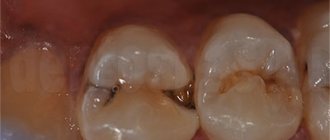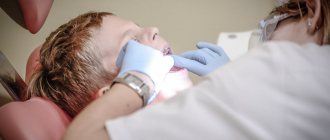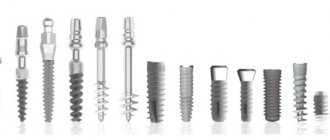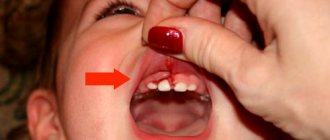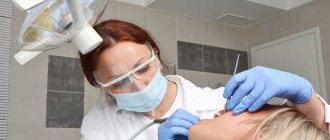There are plenty of reasons why you can lose a completely healthy tooth in our lives. In adults, the face, and along with it the jaws, are often injured in road accidents, as a result of falls, bad habits, and sometimes attempts to sort things out by force. Even more “opportunities” open up for children who love active games on playgrounds and sports grounds. In dentistry, this situation is usually called tooth dislocation.
Practice shows that many erudite adults get lost in such situations and don’t know how to behave. Meanwhile, you can save a tooth if you get an appointment with a dentist within an hour.
What to do if an adult or child knocks out a tooth?
Usually the front teeth that have one root and are easily torn off from the base are knocked out. The incisors of the upper jaw are mainly affected. Depending on the strength of the mechanical impact and the individual characteristics of the dental system, different symptoms may occur.
- With a strong blow to the dental crown, complete dislocation occurs: the tooth falls out of the socket and ends up on the floor or ground. In its place, a bleeding hole remains, in which a blood clot quickly forms. Soft labial tissue is often damaged.
- Incomplete dislocation is characterized by displacement of the crown from its normal position. It doesn’t go beyond the row, but it starts to hurt and stagger. In this case, the tooth root may become bent and stop developing. Hemorrhages and bruises are often observed in the soft tissue area.
- If mechanical impact occurs on the cutting edge of the tooth, the crown may be partially or completely immersed in the alveolus and embedded in the jaw bone tissue. Visually, there is a shortening of the tooth or its complete hiding in the bone.
Even if a child knocks out a baby tooth, only a specialist can assess the severity of the problem. You should not hope that a permanent one will soon grow in its place. The victim, along with the tooth found at the scene of the incident, must be taken to the dental clinic as quickly as possible. In this case, the clinic must admit the patient out of turn.
Complete dislocation of primary teeth
In cases where a child has knocked out baby teeth, their replantation is not provided. After the examination, the dentist must take an x-ray to make sure there is no damage to the alveolar process or impacted dislocation. In the latter case, the tooth goes into the bone plate or the rudiment of the future molar.
In addition to visiting a doctor immediately after receiving an injury, you will need to undergo a dental examination several more times, after a week and a month, respectively, and also after 6 and 12 months from the date of tooth loss. In each case, an x-ray is also taken to monitor possible deviations in the formation of the molar.
What to do in such a situation
The problem of a missing tooth in cases where there are still several years left before the eruption of molars turns out to be very serious, and it has its own reasons. An orthodontist must carry out an examination after the wound in the gum has completely healed.
When eating, the chewing load is evenly distributed between all the teeth involved in the process, but in the absence of one or more teeth, an imbalance occurs and uneven loads are formed. As a result, teeth are much less resistant to caries.
In addition, the presence of emptiness automatically leads to a gradual displacement of the teeth towards the free space. The result of this phenomenon is often incorrect teething or deviation of their position from their intended place.
The orthodontist can offer a special children's prosthesis, which is a plate that fills the empty space, but is not inserted into the bone, as in implantology. Such an artificial tooth will not only take on part of the load, but will also prevent real teeth from moving apart.
What to do with a knocked out tooth?
A “lost piece” that has fallen into snow, mud or autumn slush can only be rinsed with water, but cannot be scraped and cleaned “to a mirror shine” so as not to damage the still living fibers. For the same reasons, you should pick up the tooth by the crown, and not by the root, which will be re-engrafted into the hole. Disinfection of living tissue with alcohol or hydrogen peroxide is also prohibited.
After dislocation, the tooth should be kept in a moist environment, which will significantly increase its chances of replantation and healing. How to achieve this?
- The best natural medium that supports the vitality of a lost tooth is saliva. Therefore, the tooth can be placed in the mouth, on the opposite side from the damaged side, tucked between the cheek and gum. When a baby tooth is dislocated, a child may scream and cry. To prevent the tooth from being swallowed, its transportation can be handled by an accompanying relative—preferably the mother.
- Perhaps the adult victim or those around him have a container for storing contact lenses. The tooth can be placed in the saline solution it contains.
- A small container filled with water or milk will also work.
- If there is a pharmacy in the neighborhood, you can buy any drug that represents a physiological environment - glucose, 0.02 percent furatsilin, novocaine, etc.
First actions
If the tooth left its natural “habitat” unharmed, and you managed to find it, then you can count on the restoration of the unit. Find a small container, pour saline solution and place the tooth there. If you don’t have the necessary items on hand, you can wrap the unit in regular cloth or cotton wool. If possible, place a special cold pack next to the unit; it can be purchased at a pharmacy. In extreme cases, use ice.
If there is no heavy bleeding, it is enough to treat the oral cavity with any antiseptic liquid, Miramistin or Chlorhexidine will do. If there is severe pain, take any painkiller tablet, for example, Nise or Ketarol.
In case of heavy bleeding, you should immediately visit a doctor or call an ambulance.
Do I need to insert a tooth myself?
In case of incomplete dislocation, the crown that protrudes strongly from the gums at the scene of the incident can be carefully inserted into place without applying significant effort. This will prevent complete tooth loss, the likelihood of which is quite high. But you shouldn’t touch a knocked-out baby tooth; it’s better to quickly go to the dentist to identify possible damage to soft tissue and bone.
If a piece of a tooth breaks off, you should rinse your mouth with clean water, try to find the fragment and rush to see a qualified doctor.
The statistics for permanent teeth are as follows:
If the tooth is returned to its place within 30 minutes, it will take root in 90 percent of cases; if replantation is delayed for up to 2 hours, it will fail in 90 percent of cases. It is clear that during the first 30 minutes, first aid to the injured child will be provided by his parents. According to Polish researchers, the percentage of medical workers willing to replant a tooth at the site of injury is only 7 percent; the rest prefer to call parents to take the child to the dentist. And this is a waste of time, reducing the chance of engraftment.
Therefore, forewarned means forearmed. Tell your friends.
Where do teeth for transplantation come from?
For autotransplantation of teeth in the anterior section, premolars are considered the most suitable - the 4th and 5th small molars, which begin to erupt only during the formation of a permanent dentition. A few months after the transplant, orthodontic treatment can begin to move the teeth to close the gap.
Wisdom tooth transplantation is the best option for restoration in the chewing area. Removing the figure eight will not affect chewing food or bite formation in any way, and it will not harm the beauty of your smile. For example, transplanting a wisdom tooth into the place of the 6th or 7th tooth is successfully practiced and does not spoil the aesthetics. The main condition for the success of the operation is a sufficient degree of formation of the wisdom tooth follicle: it must be visible on an x-ray.
Is dental implantation possible in older patients? If so, what should you prepare for?
Implantation in adults is possible at almost any age. If a patient comes to our clinic whose age is over 55 years old, we know that we need to make more efforts to get results:
- You will have to come for appointments more often
. The doctor will more carefully monitor the progress of engraftment to prevent the development of inflammation and implant rejection. - A thorough examination will be required
. It is especially important that permission for the procedure is given by the therapist observing the person. The presence of diabetes and hypertension is not a strict contraindication for a number of implantation techniques. - You will need to undergo psychological training
. A high level of stress is overcome by prescribing light sedative (calming) drugs and a heart-to-heart conversation, during which the doctor will dispel the patient’s doubts and fears.
The specialists of our AcademStom clinic have successful experience in treating older patients, and we try to help everyone who comes to us.
Is it worth getting implants after 60 years of age?
Implantation is not contraindicated for people who have crossed the 60-year mark of their lives. On the contrary, successfully performed fixed prosthetics on implants improves digestion, and therefore the nutrition of the body. Therefore, you should not suffer from functional disorders of the jaw apparatus.
When collecting patient data and during treatment, our doctors listen to all complaints in order to reduce the risk of failure during implantation. They care about the health of patients. Always polite, welcoming and trying to help.
Is implantation possible for cardiovascular diseases? If yes, what are its features?
Implants are not performed in people who have recently had a heart attack. In other cases, for people with heart and vascular diseases, our dentists always try to find an alternative method for easier and gentler implantation.
In fact, the presence of problems with the cardiovascular system does not in any way affect the survival rate of the implant. Simply an increased level of stress (fear, worries) can negatively affect overall well-being, placing additional stress on cardiac activity.
The presence of hypertension may also be important. Increased pressure during the procedure can lead to bleeding. Therefore, preparatory therapy is prescribed to heart patients - sedatives and hypotensive (pressure-reducing) drugs.
Causes of dental injuries
Most often, dental damage occurs at one moment, for example, during an accident, a fall, a strong blow to the jaw, or performing a sports exercise. Sometimes a tooth shifts gradually if a future dental patient periodically chews hard objects, nails, or tears threads with his teeth. As a result of such manipulations, tooth enamel is gradually worn away and chips appear. Subsequently, the tooth may crumble during ordinary activities, such as brushing or chewing food.
In good dentistry, treatment procedures are always successful, in compliance with all rules. However, if you decide to take a risk and save money, the tooth may be destroyed if the operation is unsuccessful. For example, dislocation can occur due to inaccurate removal of nearby teeth. Injuries are also common when installing orthodontic appliances.
What implantation methods are recommended for older patients?
In gerontological practice (when treating older patients), our AcademStom dentistry more often uses methods that reduce the burden on the body. We are talking about simultaneous implantation with immediate loading:
- Immediate Load procedure
with immediate donning of a loaded prosthesis. There are several varieties of it that allow you to replace lost teeth (All-on-4 or All-on-6 protocol).
This technique has several advantages over others. It does not require bone augmentation, because the implant can be installed at an angle to avoid areas with atrophy.
It is worth noting that when using the Immediate Load technique, implantation occurs in a more gentle way. There is no need to drill into the bone and injure the tissue. It is enough to make a small puncture and carefully screw a titanium rod through it into the bone.
Prosthetics on these implants is carried out immediately (within 1-7 days after surgery). For people who have worn dentures for years or been completely toothless, having teeth that resemble their own means a lot. They are aesthetic and in no way similar to artificial ones.
In some cases, with permanent prosthetics, a special type of prosthesis may be chosen - with artificial gum. When using it, no additional work is required to install the gum former. Teeth will look aesthetically pleasing even with existing tissue deficiency caused by shrinkage due to atrophy. They can be easily touched up and adjusted later directly in the oral cavity.
What it is?
Dental transplantation or transplantation is an operation in which a dental surgeon transplants an existing tooth germ or the tooth itself to the place where it is missing. Most often, this is autotransplantation of teeth - that is, the patient’s own teeth or their rudiments are used to restore a gap in the dentition.
The transplanted tooth germ develops in the new socket in the same way as its neighbors in their native sockets. Its root system grows into the jaw bone, so the nutrition of the tooth is no different from the nutrition of its neighbors. This ensures the reliability of the transplant result. As a result, such a tooth fully replaces the lost one. This technique is used for:
- congenital absence of a tooth, when the formation of a tooth germ has not occurred;
- tooth loss due to injury;
- removal due to deep caries;
- tooth extraction on the recommendation of an orthodontist, since some defects in tooth development can lead to malocclusion.
In addition to transplantation, there is a method of tooth reimplantation. The fundamental difference between them is that during reimplantation, the doctor first removes the tooth and then implants it in the same socket. Most often, this technique is used to eliminate a source of infection that cannot be eliminated by conservative therapy. A common feature of reimplantation and tooth transplantation is that it is important to preserve the integrity of the tooth and its roots.
What are the features of implantation for osteoporosis?
This disease often affects women in menopause. Hormonal changes in the body do not go unnoticed, and some people develop osteoporosis due to calcium loss. These are areas where the bone ceases to be hard and becomes loose. An implant cannot be implanted in such a place, since there will be no primary stabilization. Bone augmentation will improve bone tissue performance.
The doctor may also suggest an implantation method designed to bypass the problem area. It is worth noting that implant prosthetics have a good effect on the general condition of the bone in osteoporosis. Destructive processes stop against the background of improved blood circulation, and new lesions do not appear.
How is the transplant done?
The best option for a successful transplant is a tooth germ surrounded by a follicle in which roots have not yet formed. The dental follicle or dental sac consists of cells and fibers that surround the tooth germ.
Tooth transplantation - stages:
- diagnostic - obtaining x-rays, performing computed tomography;
- removal of the affected tooth;
- washing the hole with a solution of an antiseptic and antibiotic - if necessary, leave a tampon in it if removal and transplantation are carried out on different days;
- extracting a healthy tooth or its germ from the socket;
- implanting it in place of a removed or lost tooth;
- fixation with a splint;
- suturing.
After an average of 25 days, the splints are removed. During this time, the tooth should take root in its new location. This technology completely restores the beauty of the smile, chewing functions and helps prevent the development of bite defects, since the teeth can shift towards the defect, filling the empty space.

